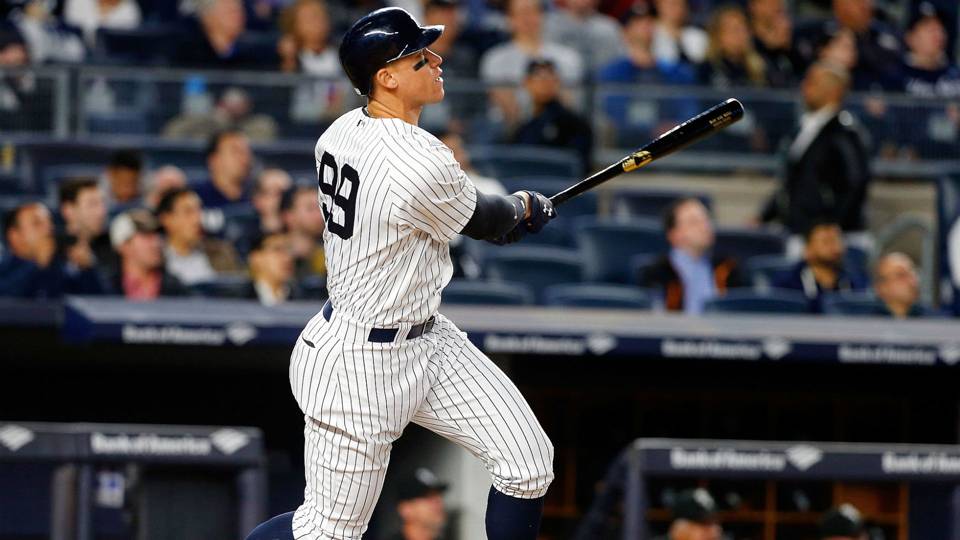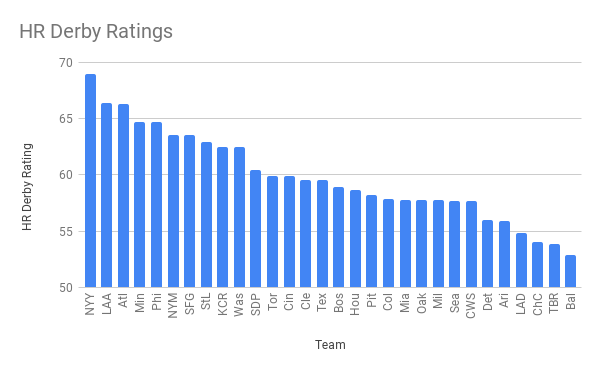Extra Inning Home Run Derby in MLB?

If you think the ghost runner on second base is an abomination, avert your eyes. This season, the Pioneer League will decide games via home run derby after the ninth inning. Each team will send up their best slugger to take five swings in a winner-take-all battle. If the score is still tied after that, they each send up their second-best player, and so on.
The Pioneer League is one of the independent partner leagues of Major League Baseball. They’ve agreed to serve as MLB’s crash test dummy for several new rules. This isn’t one of them— the Pioneer League is, uh, pioneering this all on their own— but MLB will undoubtedly pay attention to how it plays out.
The home run derby could become a huge success. After all, if they didn’t adopt this rule, you probably wouldn’t be reading an article about the Pioneer League today. Let’s say MLB loves it and decides to give it a whirl. Which teams would have the biggest advantage?
Home Run Derby Rating
Before we can figure out which clubs would be most successful in the home run derby format, we need to identify which players would be the best. That involves a bit of guesswork because hitting in a derby and facing a pitcher in an actual ballgame are two vastly different skills that are only loosely connected. Nevertheless, here are three Statcast metrics that might give us some idea:
- Max Exit Velocity– the absolute hardest each player has hit a ball this season
- Hard Hit Rate- the percentage of batted balls greater than 95 mph
- Sweet Spot Percentage- the rate at which each player optimizes their launch angle
Giving all three of these metrics equal weight, we can assign every player with at least 25 batted balls in 2021 a home run derby rating (HRDR) on the 20-80 scouting scale. The average HRDR score is 50 and every ten points above or below is a full standard deviation. The HRDR leaders pass the sniff test:
- Aaron Judge, 70
- Ronald Acuña, Jr., 68
- Mike Trout, 67
- Byron Buxton, 65
- Bryce Harper, 65
The second-worst player was Nicky Lopez, who scored a 30. Tony Kemp scored a 20! He’s last in MLB in max exit velo and sweet spot percentage as well as second-last in hard hit rate. Imagine being a full standard deviation worse at hitting for power than Lopez! Picture 2001 Barry Bonds. Kemp is the polar opposite. If they were teammates, Lopez would be legally obligated to stuff Kemp into a locker.
Team Home Run Derby Rating
The Pioneer League isn’t running the home run derby rule like a batting order. Any player the manager chooses can take their swings. In our fictitious MLB version, this means Aaron Judge ought to participate most of the time for the New York Yankees and Tony Kemp never steps in the box for the Oakland A’s.
However, creating a team HRDR score isn’t as simple as just finding each club’s best player. First of all, no one plays every single game. Players get hurt and take rests. Let’s assume the biggest bopper is unavailable ten percent of the time. We also need to account for extra rounds. If the first round of the extra-inning derby is tied after five swings for each side, a second hitter comes to bat. There are six possible home run totals after five swings: 0, 1, 2, 3, 4, and 5. Assuming each outcome is equally likely (they probably aren’t, but we can’t know that yet), there is a 1/36 chance each round will end in a tie. Now we can assign weights to each team’s HRDR leaders:
- Best HRDR score on the team: 87.2%
- 2nd-best HRDR score: 11.2%
- 3rd-best HRDR score: 1.4%
- 4th-best HRDR score: 0.2%
- 5th-best HRDR score: 0.02%
There is a 0.003% chance a team will need their sixth-best power hitter, so we’ll just stop after five. Clearly, this benefits teams with two great power hitters more than a lineup stacked full of good ones. For example, the Boston Red Sox have five good-not-great HRDR sluggers: Rafael Devers (59), Bobby Dalbec (59), J. D. Martinez (57), Alex Verdugo (57), and Xander Bogaerts (56). Devers’ score is only 28th best in MLB though, so they suffer in the rankings. Speaking of which…
HRDR Rankings

The Yankees tower over the rest of the league thanks to HRDR leader Aaron Judge and 12th-place Giancarlo Stanton. No team has a more fearsome five than the Minnesota Twins. Their fifth-best bopper is Mitch Garver (59), who would have been numero uno on 11 other teams. With the weighted formula, Minnesota trails the Trout/Ohtani Los Angeles Angels and the Acuña/Freeman Atlanta Braves.
Two AL East teams bring up the rear. The Baltimore Orioles’ best option is Ryan Mountcastle (53) and the Tampa Bay Rays would turn to Austin Meadows (54) to save the game after the ninth inning. The Yankees play these two clubs a combined 38 times each year. This rule would undoubtedly swing a few wins in New York’s direction.
Given that this wasn’t one of the MLB-Pioneer League collaboration rules, don’t expect to see home run derbies in MLB anytime soon. That’s for the best; baseball games should be decided by actual pitchers and a batting order, not glorified batting practice. Then again, it would at least be more exciting than the runner on second base!












